Bulguksa
Our driver also turned out to be a registered guide to our first location, Bulguksa, a nearby temple dating back to 751 A.D. which was not only famous in Korea, but also became a UNESCO World Heritage site in 1995. So he gave us a bit of a tour as well as taking pictures of us both, which turned out to be an added benefit of hiring him. It was very bright and sunny but terribly cold, so there weren't many other people at Bulguksa. While it must be a very beautiful place in the spring and autumn, it was nice that the place wasn't overcrowded because it felt more spiritual and I could take nicer photos.
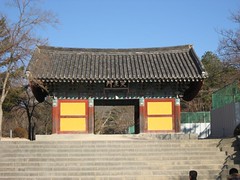
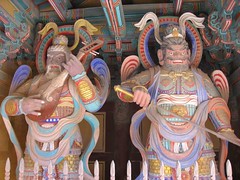
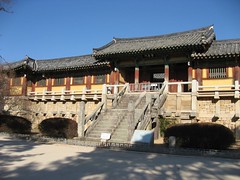
Now this is where I ran into a bit of a problem. Or rather, I had a run in with a group of Koreans while wandering on my own. There's a rule in Korea that you don't take photos of the statues of Buddha inside certain temple buildings, and signs in Korean and English state "No Photos" at the doorways. I respect the rule. But standing about 50 meters away from a particular building trying to get a general shot of a courtyard with a small temple building in the centre I was suddenly accosted by said Koreans whose leader kept repeating the phrase "No Photos!" I wasn't too impressed with this particularly given the fact that because I was taking the photo from such a distance and at an angle it was highly unlikely that anything inside the temple would be visible, and certainly not the statue of Buddha.
So I launched into a futile attempt at defending myself, pointing to the building in the best sign language I could muster and indicating I knew very well that photos weren't permitted inside the temple but we were outside and far away. He replied to my international attempts at communication with his own - the internationally recognisable smug smile of a self-appointed superior. He repeated "No Photos!" a few more times and I was half-a-second away from advising a short course of attempted asexual reproduction to him when I wisely thought better of it. Instead I opted to try and explain my position quickly in English which I knew he wouldn't understand and I thought would irritate him. He and his little lynch mob then walked off, laughing.
Paranoia inevitably dictates I conclude that had I been Korean, they'd have left me alone.
I hadn't given much thought to the whole business of Buddha photos before, but had assumed it had religious reasons. So I was surprised to discover shortly afterwards in the nearby gift shop all manner of photographs of Bulguksa's Buddhas available for purchase. So, perhaps the photo rule was really about not disturbing worshippers, because otherwise the whole thing was completely hypocritical.
Anyway, my experience of Bulguksa was somewhat soured, and Buddhism and Korea didn't earn themselves any points either.
Seokguram
Very far up a mountain close to Bulguksa lies the Seokguram Grotto, an artificial cave into which beautifully carved figures of Buddha amongst others. Another UNESCO World Heritage Site, the authorities are so concerned about protecting the grotto that a glass window now separates it from the outside world and a security guard watches the visitors as they pass. Photos are forbidden although the Wikipedia page has one.
I don't know how it came about, but there are slates available which mainly international visitors write various thoughts, messages and prayers on. There wasn't much else so see though.
It was terribly windy and what I'll remember more than anything is how blue my fingers went as I battled to take pictures of the views from the mountain. It's truly remarkable to see the mountains in the valley below and realise how much higher up you are.
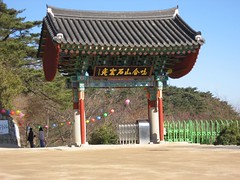
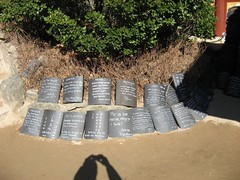
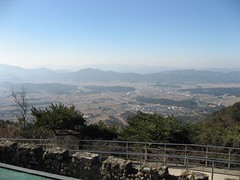
King Munmu's Tomb
When King Munmu died he wanted his ashes scattered at sea - result, underwater tomb. In truth there wasn't much to see here but the beach was nice and the surf spectacular.
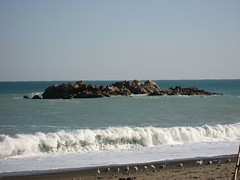
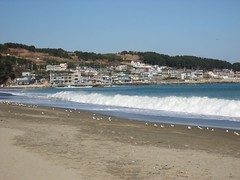
Gameunsaji Temple Site
Next it was on to this temple site, though there's little of the temple actually left now, save for twin pagodas, one of which was being repaired. Next to the pagodas stands a large tree, which our guide told us was the local 'village tree', a central part of shaman rituals.


Golgulsa
Our third temple of the day, Golgusa, is quite famous for the martial arts practices of its monks - so much so that it had been featured in a TV programme back in the UK. The monks perfect their skills in the mountainous terrain and sometimes in small area in front of one of the temples, though there was no sign of life when we were there. Natural caves in the mountainside house small temples and high up in the cliffs is the Maayeyeoraejwasang Buddha statue carved into the rock. I actually climbed up to it - no mean feat on a somewhat average Meniere's day, but by the time I got up there I felt so ill I had to come straight back down - so no close up pictures.
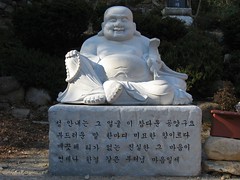
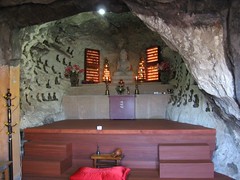
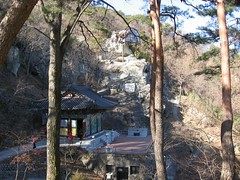
Girimsa
Our final temple of the day (is it possible to get temple fatigue?) was Girimsa, which used to be so large Bulguksa was a subsidiary temple, but now the opposite is the case. We didn't spend long here as our taxi driver had said he would take us to a folk village if we were quick, so we just had a dash around. It was long enough to discover the inevitable vending machines underneath the otherwise beautiful building housing the temple bell. Sometimes I wonder about the whole tourism thing.
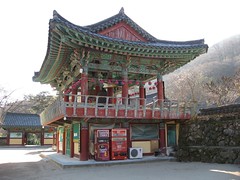
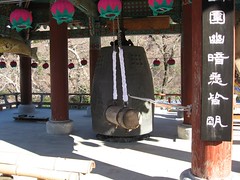
The temple was deserted and in a fit of spite and annoyed at the hypocrisy of the 'No Photo' incident earlier in the day, I took a picture inside one of the temple buildings. A minute later my conscience dressed as a Buddhist Monk appeared from another building and hung around us for no definable reason. We left.
Bomun Mulebang-a
On the way to the folk village we briefly stopped off here - the largest waterwheel in Korea. A mill is attached where flour used to be made.
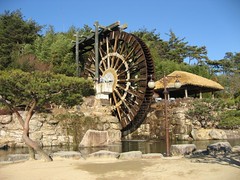
Wolseong Yangdong Village
The final stop of the day was at a traditional Korean folk village, which is to say the architecture has been kept to a 15th to 16th century style - obviously apart from the church which defiantly ruins the view.
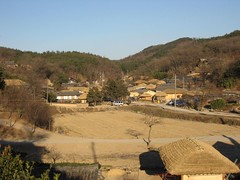

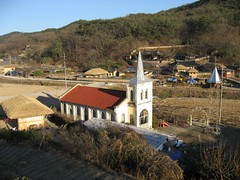
The local guidebook says the Wolseong Yangdong "is a folk village designated as Important Folk Materials No. 189". Honestly, I'm not really any the wiser. All the cultural sights in Gyeongju are, by the way, helpfully numbered and categorised in addition to being well signed in Korean, English and Japanese.
The village isn't just a tourist attraction, it's a place where people live, hence the sign outside one house requesting that visitors 'respect our privacy' and the implication that people should turn around and go away was clear. The existence of satellite dishes on the side of the houses and of course the telegraph poles not to mention other trappings of the modern world did little to add to the atmosphere.
One of the more impressive buildings was the clan house of the Yeogang I clan (National Treasure no. 412), but there was little to see inside. With my bad karma seeking me out after earlier Buddhist run-ins, I did however manage to head butt the side of the house extremely hard by walking into an unexpectedly low side-beam, leaving me with a headache for several hours afterwards.
There's something slightly surreal about being chauffeured around in a taxi as your personal transport all day, but it was very convenient, and meant that after our dash round some of the local sights, we could go straight back home for a more relaxing evening, or so I thought...
No comments:
Post a Comment